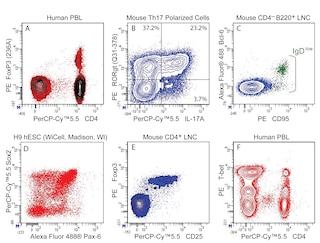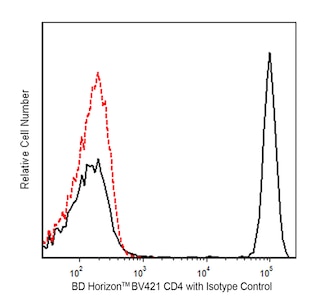-
Reagents
- Flow Cytometry Reagents
-
Western Blotting and Molecular Reagents
- Immunoassay Reagents
-
Single-Cell Multiomics Reagents
- BD® OMICS-Guard Sample Preservation Buffer
- BD® AbSeq Assay
- BD® Single-Cell Multiplexing Kit
- BD Rhapsody™ ATAC-Seq Assays
- BD Rhapsody™ Whole Transcriptome Analysis (WTA) Amplification Kit
- BD Rhapsody™ TCR/BCR Next Multiomic Assays
- BD Rhapsody™ Targeted mRNA Kits
- BD Rhapsody™ Accessory Kits
- BD Rhapsody™ TCR/BCR Profiling Assays for Human and Mouse
-
Functional Assays
-
Microscopy and Imaging Reagents
-
Cell Preparation and Separation Reagents
-
- BD® OMICS-Guard Sample Preservation Buffer
- BD® AbSeq Assay
- BD® Single-Cell Multiplexing Kit
- BD Rhapsody™ ATAC-Seq Assays
- BD Rhapsody™ Whole Transcriptome Analysis (WTA) Amplification Kit
- BD Rhapsody™ TCR/BCR Next Multiomic Assays
- BD Rhapsody™ Targeted mRNA Kits
- BD Rhapsody™ Accessory Kits
- BD Rhapsody™ TCR/BCR Profiling Assays for Human and Mouse
- Belgium (English)
-
Change country/language
Old Browser
This page has been recently translated and is available in French now.
Looks like you're visiting us from {countryName}.
Would you like to stay on the current country site or be switched to your country?


.png)

Two-color flow cytometric analysis of Helios expression Left Panel: Human peripheral blood mononuclear cells were stained with BD Horizon™ BV421 Mouse Anti-Human CD4 antibody (Cat No. 562424/562425) and fixed and permeabilized with the BD Pharmingen™ Transcription Factor Buffer Set (Cat. No. 562574/562725). The cells were then stained with either PE Hamster IgG2, κ Isotype Control (Cat No. 550085, Left Plot) or PE Armenian Hamster Anti-Helios antibody (Cat. No. 563801; Right Plot). Right Panel: Mouse splenic leucocytes were stained with BD Horizon™ BV421 Rat Anti-Mouse CD4 antibody (Cat No. 562891) and fixed and permeabilized with the BD Transcription Factor Buffer Set. The cells were then stained with either PE Hamster IgG2, κ Isotype Control (Left Plot) or PE Armenian Hamster Anti-Helios antibody (Right Plot). The two-color flow cytometric dot plots show the correlated expression patterns of Helios (or Ig Isotype control staining) versus CD4 for gated events with the forward and side light-scatter characteristics of intact human peripheral blood lymphocytes or splenic leucocytes. Flow cytometric analysis was performed using a BD FACSCanto™ II Flow Cytometer System.
.png)

BD Pharmingen™ PE Armenian Hamster Anti-Helios
.png)
Regulatory Status Legend
Any use of products other than the permitted use without the express written authorization of Becton, Dickinson and Company is strictly prohibited.
Preparation And Storage
Product Notices
- Since applications vary, each investigator should titrate the reagent to obtain optimal results.
- An isotype control should be used at the same concentration as the antibody of interest.
- Caution: Sodium azide yields highly toxic hydrazoic acid under acidic conditions. Dilute azide compounds in running water before discarding to avoid accumulation of potentially explosive deposits in plumbing.
- For fluorochrome spectra and suitable instrument settings, please refer to our Multicolor Flow Cytometry web page at www.bdbiosciences.com/colors.
- Please refer to www.bdbiosciences.com/us/s/resources for technical protocols.
Companion Products



.png?imwidth=320)


The 22F6 monoclonal antibody specifically binds to mouse and human Helios. Helios is a member of the Ikaros family of zinc-finger transcription factors, which play important roles in hematopoietic cell development and tumor suppression. Helios expression is restricted to the earliest stages of embryonic hematopoiesis, a variety of epithelial tissues and is notably increased in thymic-derived regulatory CD4+Foxp3+ T (Treg) cells. Its high expression levels in Treg cells are independent from Foxp3 and are believed to contribute, along with other transcription factors, to the phenotypic stability of natural regulatory T cells. Accordingly, it has been demonstrated that Helios directly stimulates Foxp3 transcription while it inhibits ll2 gene expression, contributing for the maintenance of cellular anergy. Helios is also differentially expressed during negative and positive selection in the thymus, marking CD4+ autoreactive cells for deletion. Helios may possibly play roles in T cell activation, since it is upregulated in Th2 and Tfh cells. Despite these roles in T cell development and function, Helios genetic ablation in mice revealed no significant abnormalities in Treg or other T cell subsets. This finding suggests that other Ikaros family members may play redundant roles.

Development References (9)
-
Baine I, Basu S, Ames R, Sellers RS, Macian F. Helios induces epigenetic silencing of IL2 gene expression in regulatory T cells. J Immunol. 2013; 190(3):1008-1016. (Biology). View Reference
-
Cai Q, Dierich A, Oulad-Abdelghani M, Chan S, Kastner P. Helios deficiency has minimal impact on T cell development and function. J Immunol. 183(4)(Biology). View Reference
-
Daley SR, Hu DY, Goodnow CC. Helios marks strongly autoreactive CD4+ T cells in two major waves of thymic deletion distinguished by induction of PD-1 or NF-kappaB. J Exp Med. 2013; 210(2):269-285. (Biology). View Reference
-
Fu W, Ergun A, Lu T, et al. A multiply redundant genetic switch 'locks in' the transcriptional signature of regulatory T cells. Nat Immunol. 2012; 13(10):972-980. (Biology). View Reference
-
Georgopoulos K. Haematopoietic cell-fate decisions, chromatin regulation and ikaros. Nat Rev Immunol. 2002; 2(3):162-174. (Biology). View Reference
-
Kelley CM, Ikeda T, Koipally J, et al. Helios, a novel dimerization partner of Ikaros expressed in the earliest hematopoietic progenitors. Curr Biol. 1998; 8(9):508-515. (Biology). View Reference
-
Serre K, Benezech C, Desanti G, et al. Helios is associated with CD4 T cells differentiating to T helper 2 and follicular helper T cells in vivo independently of Foxp3 expression. PLoS ONE. 2011; 6(6):e20731. (Biology). View Reference
-
Sugimoto N, Oida T, Hirota K, et al. Foxp3-dependent and -independent molecules specific for CD25+CD4+ natural regulatory T cells revealed by DNA microarray analysis. Int Immunol. 18(8)(Biology). View Reference
-
Thornton AM, Korty PE, Tran DQ, et al. Expression of Helios, an Ikaros transcription factor family member, differentiates thymic-derived from peripherally induced Foxp3+ T regulatory cells. J Immunol. 2010; 184(7):3433-3441. (Immunogen: ELISA, Flow cytometry, Western blot). View Reference
Please refer to Support Documents for Quality Certificates
Global - Refer to manufacturer's instructions for use and related User Manuals and Technical data sheets before using this products as described
Comparisons, where applicable, are made against older BD Technology, manual methods or are general performance claims. Comparisons are not made against non-BD technologies, unless otherwise noted.
For Research Use Only. Not for use in diagnostic or therapeutic procedures.
Report a Site Issue
This form is intended to help us improve our website experience. For other support, please visit our Contact Us page.